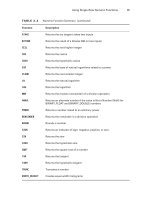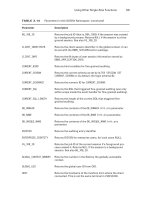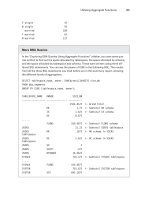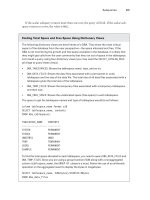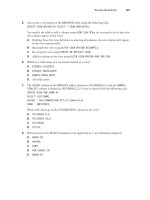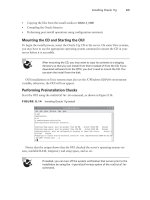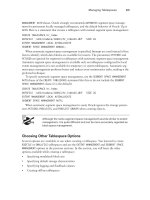Tài liệu OCA: Oracle Database 11g Administrator Certified Associate Study Guide- P3 ppt
Bạn đang xem bản rút gọn của tài liệu. Xem và tải ngay bản đầy đủ của tài liệu tại đây (631.15 KB, 50 trang )
Writing Simple Queries
31
> (Greater Than)
The
>
operator evaluates to
TRUE
if the left side (expression or value) of the operator is
greater than the right side of the operator.
SELECT first_name || ‘ ‘ || last_name “Name”, commission_pct
FROM employees
WHERE commission_pct > .35;
Name COMMISSION_PCT
------------------------------------------ --------------
John Russell .4
<= (Less Than or Equal to)
The
<=
operator evaluates to
TRUE
if the left side (expression or value) of the operator is less
than or equal to the right side of the operator.
SELECT first_name || ‘ ‘ || last_name “Name”, commission_pct
FROM employees
WHERE commission_pct <= .15;
Name COMMISSION_PCT
------------------------------------------ --------------
Oliver Tuvault .15
Danielle Greene .15
Mattea Marvins .1
David Lee .1
Sundar Ande .1
Amit Banda .1
William Smith .15
Elizabeth Bates .15
Sundita Kumar .1
Kimberely Grant .15
Charles Johnson .1
11 rows selected.
>= (Greater Than or Equal to)
The
>=
operator evaluates to
TRUE
if the left side (expression or value) of the operator is
greater than or equal to the right side of the operator.
SELECT first_name || ‘ ‘ || last_name “Name”, commission_pct
FROM employees
WHERE commission_pct >= .35;
95127c01.indd 31 2/18/09 6:37:09 AM
Please purchase PDF Split-Merge on www.verypdf.com to remove this watermark.
32
Chapter 1
N
Introducing SQL
Name COMMISSION_PCT
------------------------------------------ --------------
John Russell .4
Janette King .35
Patrick Sully .35
Allan McEwen .35
ANY or SOME
You can use the
ANY
or
SOME
operator to compare a value to each value in a list or subquery.
The
ANY
and
SOME
operators always must be preceded by one of the following comparison
operators:
=
,
!=
,
<
,
>
,
<=
, or
>=
.
SELECT first_name || ‘ ‘ || last_name “Name”, department_id
FROM employees
WHERE department_id <= ANY (10, 15, 20, 25);
Name DEPARTMENT_ID
------------------------------------------- -------------
Jennifer Whalen 10
Michael Hartstein 20
Pat Fay 20
ALL
You can use the
ALL
operator to compare a value to every value in a list or subquery. The
ALL
operator must always be preceded by one of the following comparison operators:
=
,
!=
,
<
,
>
,
<=
, or
>=
.
SELECT first_name || ‘ ‘ || last_name “Name”, department_id
FROM employees
WHERE department_id >= ALL (80, 90, 100);
Name DEPARTMENT_ID
------------------------------------------- -------------
Nancy Greenberg 100
Daniel Faviet 100
John Chen 100
Ismael Sciarra 100
Jose Manuel Urman 100
Luis Popp 100
Shelley Higgins 110
William Gietz 110
8 rows selected.
For all the comparison operators discussed, if one side of the operator is
NULL
, the result is
NULL
.
95127c01.indd 32 2/18/09 6:37:10 AM
Please purchase PDF Split-Merge on www.verypdf.com to remove this watermark.
Writing Simple Queries
33
Logical Operators
Logical operators are used to combine the results of two comparison conditions (compound
conditions) to produce a single result or to reverse the result of a single comparison.
NOT
,
AND
, and
OR
are the logical operators. When a logical operator is applied to
NULL
, the result
is
UNKNOWN
.
UNKNOWN
acts similarly to
FALSE
; the only difference is that
NOT FALSE
is
TRUE
,
whereas
NOT UNKNOWN
is also
UNKNOWN
.
NOT
You can use the
NOT
operator to reverse the result. It evaluates to
TRUE
if the operand is
FALSE
, and it evaluates to
FALSE
if the operand is
TRUE
.
NOT
returns
NULL
if the operand
is
NULL
.
WHERE !(department_id >= 30)
*
ERROR at line 3:
SELECT first_name, department_id
FROM employees
WHERE not (department_id >= 30);
FIRST_NAME DEPARTMENT_ID
-------------------- -------------
Jennifer 10
Michael 20
Pat 20
AND
The
AND
operator evaluates to
TRUE
if both operands are
TRUE
. It evaluates to
FALSE
if either
operand is
FALSE
. Otherwise, it returns
NULL
.
SELECT first_name, salary
FROM employees
WHERE last_name = ‘Smith’
AND salary > 7500;
FIRST_NAME SALARY
-------------------- ----------
Lindsey 8000
95127c01.indd 33 2/18/09 6:37:10 AM
Please purchase PDF Split-Merge on www.verypdf.com to remove this watermark.
34
Chapter 1
N
Introducing SQL
OR
The
OR
operator evaluates to
TRUE
if either operand is
TRUE
. It evaluates to
FALSE
if both
operands are
FALSE
. Otherwise, it returns
NULL
.
SELECT first_name, last_name
FROM employees
WHERE first_name = ‘Kelly’
OR last_name = ‘Smith’;
FIRST_NAME LAST_NAME
-------------------- -------------------------
Lindsey Smith
William Smith
Kelly Chung
Logical Operator Truth Tables
The following tables are the truth tables for the three logical operators.
Table 1.7 is a truth table for the
AND
operator.
TABLE 1.7
AND
Truth Table
AND TRUE FALSE UNKNOWN
TRUE TRUE FALSE UNKNOWN
FALSE FALSE FALSE FALSE
UNKNOWN UNKNOWN FALSE UNKNOWN
Table 1.8 is the truth table for the
OR
operator.
TABLE 1.8
OR
Truth Table
OR TRUE FALSE UNKNOWN
TRUE TRUE TRUE TRUE
FALSE TRUE FALSE UNKNOWN
UNKNOWN TRUE UNKNOWN UNKNOWN
95127c01.indd 34 2/18/09 6:37:10 AM
Please purchase PDF Split-Merge on www.verypdf.com to remove this watermark.
Writing Simple Queries
35
Table 1.9 is the truth table for the
NOT
operator.
TABLE 1.9
NOT
Truth Table
NOT
TRUE FALSE
FALSE TRUE
UNKNOWN UNKNOWN
Other Operators
In the following sections, I will discuss all the operators that can be used in the
WHERE
clause of the SQL statement that were not discussed earlier.
IN and NOT IN
You can use the
IN
and
NOT IN
operators to test a membership condition.
IN
is equivalent
to the
=ANY
operator, which evaluates to
TRUE
if the value exists in the list or the result set
from a subquery. The
NOT IN
operator is equivalent to the
!=ALL
operator, which evaluates
to
TRUE
if the value does not exist in the list or the result set from a subquery. The following
examples demonstrate how to use these two operators:
SELECT first_name, last_name, department_id
FROM employees
WHERE department_id IN (10, 20, 90);
FIRST_NAME LAST_NAME DEPARTMENT_ID
-------------------- ------------------------- ----------
Steven King 90
Neena Kochhar 90
Lex De Haan 90
Jennifer Whalen 10
Michael Hartstein 20
Pat Fay 20
6 rows selected.
SELECT first_name, last_name, department_id
FROM employees
WHERE department_id NOT IN
(10, 30, 40, 50, 60, 80, 90, 110, 100);
95127c01.indd 35 2/18/09 6:37:10 AM
Please purchase PDF Split-Merge on www.verypdf.com to remove this watermark.
36
Chapter 1
N
Introducing SQL
FIRST_NAME LAST_NAME DEPARTMENT_ID
-------------------- ---------------------- -------------
Michael Hartstein 20
Pat Fay 20
Hermann Baer 70
SQL>
When using the
NOT IN
operator, if any value in the list or the result
returned from the subquery is
NULL
, the
NOT IN
condition is evaluated to
FALSE
. For example,
last_name not in (‘Smith’, ‘Thomas’, NULL)
evaluates to
last_name != ‘Smith’ AND last_name != ‘Thomas’ AND
last_name != NULL
. Any comparison on a
NULL
value results in
NULL
. So,
the previous condition does not return any row even through there may
be some rows with
LAST_NAME
as
Smith
or
Thomas
.
BETWEEN
You can use the
BETWEEN
operator to test a range.
BETWEEN A AND B
evaluates to
TRUE
if the
value is greater than or equal to
A
and less than or equal to
B
. If
NOT
is used, the result is the
reverse. The following example lists all the employees whose salary is between $5,000 and
$6,000:
SELECT first_name, last_name, salary
FROM employees
WHERE salary BETWEEN 5000 AND 6000;
FIRST_NAME LAST_NAME SALARY
-------------------- ------------------------- ----------
Bruce Ernst 6000
Kevin Mourgos 5800
Pat Fay 6000
EXISTS
The
EXISTS
operator is always followed by a subquery in parentheses.
EXISTS
evaluates to
TRUE
if the subquery returns at least one row. The following example lists the employees
who work for the administration department. Here is an example of using
EXISTS
. Don’t
worry if you do not understand the SQL for now; subqueries are discussed in detail in
Chapter 4, “Using Joins and Subqueries.”
SELECT last_name, first_name, department_id
FROM employees e
WHERE EXISTS (select 1 FROM departments d
95127c01.indd 36 2/18/09 6:37:10 AM
Please purchase PDF Split-Merge on www.verypdf.com to remove this watermark.
Writing Simple Queries
37
WHERE d.department_id = e.department_id
AND d.department_name = ‘Administration’);
LAST_NAME FIRST_NAME DEPARTMENT_ID
---------------------- -------------------- -------------
Whalen Jennifer 10
SQL>
IS NULL and IS NOT NULL
To find the
NULL
values or
NOT NULL
values, you need to use the
IS NULL
operator. The
=
or
!=
operator will not work with
NULL
values.
IS NULL
evaluates to
TRUE
if the value is
NULL
.
IS NOT NULL
evaluates to
TRUE
if the value is not
NULL
. To find the employees who do not
have a department assigned, use this query:
SELECT last_name, department_id
FROM employees
WHERE department_id IS NULL;
LAST_NAME DEPARTMENT_ID
------------------------- -------------
Grant
SQL>
SELECT last_name, department_id
FROM employees
WHERE department_id = NULL;
no rows selected
LIKE
Using the
LIKE
operator, you can perform pattern matching. The pattern-search character
%
is used to match any character and any number of characters. The pattern-search character
_
is used to match any single character. If you are looking for the actual character
%
or
_
in the
pattern search, you can include an escape character in the search string and notify Oracle
using the
ESCAPE
clause.
The following query searches for all employees whose first name begins with Su and last
name does not begin with S:
SELECT first_name, last_name
FROM employees
WHERE first_name LIKE ‘Su%’
AND last_name NOT LIKE ‘S%’;
95127c01.indd 37 2/18/09 6:37:10 AM
Please purchase PDF Split-Merge on www.verypdf.com to remove this watermark.
38
Chapter 1
N
Introducing SQL
FIRST_NAME LAST_NAME
-------------------- -------------------------
Sundar Ande
Sundita Kumar
Susan Mavris
The following example looks for all
JOB_ID
values that begin with AC_. Since
_
is a
pattern-matching character, you must qualify it with an escape character. Oracle does not
have a default escape character.
SELECT job_id, job_title
FROM jobs
WHERE job_id like ‘AC\_%’ ESCAPE ‘\’;
JOB_ID JOB_TITLE
---------- -----------------------------------
AC_MGR Accounting Manager
AC_ACCOUNT Public Accountant
Table 1.10 shows more examples of pattern matching.
TABLE 1.10 Pattern-Matching Examples
Pattern Matches Does Not Match
%SONI_1 SONIC1
,
ULTRASONI21 SONICS1
,
SONI315
_IME TIME
,
LIME IME
,
CRIME
\%SONI_1 ESCAPE ‘\’ %SONIC1
,
%SONI91 SONIC1
,
ULTRASONIC1
%ME\_ _ _LE ESCAPE ‘\’ CRIME_FILE
,
TIME_POLE CRIMESPILE
,
CRIME_ALE
Sorting Rows
The
SELECT
statement may include the
ORDER BY
clause to sort the resulting rows in a specific
order based on the data in the columns. Without the
ORDER BY
clause, there is no guarantee
that the rows will be returned in any specific order. If an
ORDER BY
clause is specified, by
default the rows are returned by ascending order of the columns specified. If you need to
sort the rows in descending order, use the keyword
DESC
next to the column name. You
can specify the keyword
ASC
to explicitly state to sort in ascending order, although it is the
95127c01.indd 38 2/18/09 6:37:10 AM
Please purchase PDF Split-Merge on www.verypdf.com to remove this watermark.
Writing Simple Queries
39
default. The
ORDER BY
clause follows the
FROM
clause and the
WHERE
clause in the
SELECT
statement.
To retrieve all employee names of department 90 from the
EMPLOYEES
table ordered by
last name, use this query:
SELECT first_name || ‘ ‘ || last_name “Employee Name”
FROM employees
WHERE department_id = 90
ORDER BY last_name;
Employee Name
----------------------------------------------
Lex De Haan
Steven King
Neena Kochhar
SQL>
You can specify more than one column in the
ORDER BY
clause. In this case, the result
set will be ordered by the first column in the
ORDER BY
clause, then the second, and so on.
Columns or expressions not used in the
SELECT
clause can also be used in the
ORDER BY
clause. The following example shows how to use
DESC
and multiple columns in the
ORDER
BY
clause:
SELECT first_name, hire_date, salary, manager_id mid
FROM employees
WHERE department_id IN (110,100)
ORDER BY mid ASC, salary DESC, hire_date;
FIRST_NAME HIRE_DATE SALARY MID
-------------------- --------- ---------- ----------
Shelley 07-JUN-94 12000 101
Nancy 17-AUG-94 12000 101
Daniel 16-AUG-94 9000 108
John 28-SEP-97 8200 108
Jose Manuel 07-MAR-98 7800 108
Ismael 30-SEP-97 7700 108
Luis 07-DEC-99 6900 108
William 07-JUN-94 8300 205
8 rows selected.
SQL>
95127c01.indd 39 2/18/09 6:37:10 AM
Please purchase PDF Split-Merge on www.verypdf.com to remove this watermark.
40
Chapter 1
N
Introducing SQL
You can use column alias names in the
ORDER BY
clause.
If the
DISTINCT
keyword is used in the
SELECT
clause, you can use only those columns
listed in the
SELECT
clause in the
ORDER BY
clause. If you have used any operators on columns in
the
SELECT
clause, the
ORDER BY
clause also should use them. Here is an example:
SELECT DISTINCT ‘Region ‘ || region_id
FROM countries
ORDER BY region_id;
ORDER BY region_id
*
ERROR at line 3:
ORA-01791: not a SELECTed expression
SELECT DISTINCT ‘Region ‘ || region_id
FROM countries
ORDER BY ‘Region ‘ || region_id;
‘REGION’||REGION_ID
-----------------------------------------------
Region 1
Region 2
Region 3
Region 4
Not only can you use the column name or column alias to sort the result set of a query,
but you can also sort the results by specifying the position of the column in the
SELECT
clause.
This is useful if you have a lengthy expression in the
SELECT
clause and you need the results
sorted on this value. The following example sorts the result set using positional values:
SELECT first_name, hire_date, salary, manager_id mid
FROM employees
WHERE department_id IN (110,100)
ORDER BY 4, 2, 3;
FIRST_NAME HIRE_DATE SALARY MID
-------------------- --------- ---------- ----------
Shelley 07-JUN-94 12000 101
95127c01.indd 40 2/18/09 6:37:10 AM
Please purchase PDF Split-Merge on www.verypdf.com to remove this watermark.
Writing Simple Queries
41
Nancy 17-AUG-94 12000 101
Daniel 16-AUG-94 9000 108
John 28-SEP-97 8200 108
Ismael 30-SEP-97 7700 108
Jose Manuel 07-MAR-98 7800 108
Luis 07-DEC-99 6900 108
William 07-JUN-94 8300 205
8 rows selected.
The
ORDER BY
clause cannot have more than 255 columns or expressions.
Sorting NULLs
By default, in an ascending-order sort, the
NULL
values appear at the bottom of the result set;
that is,
NULL
s are sorted higher. For descending-order sorts,
NULL
values appear at the top
of the result set—again,
NULL
values are sorted higher. You can change the default behavior
by using the
NULLS FIRST
or
NULLS LAST
keyword, along with the column names (or alias
names or positions). The following examples demonstrate how to use
NULLS FIRST
in an
ascending sort:
SELECT last_name, commission_pct
FROM employees
WHERE last_name LIKE ‘R%’
ORDER BY commission_pct ASC, last_name DESC;
LAST_NAME COMMISSION_PCT
------------------------- --------------
Russell .4
Rogers
Raphaely
Rajs
SELECT last_name, commission_pct
FROM employees
WHERE last_name LIKE ‘R%’
ORDER BY commission_pct ASC NULLS FIRST, last_name DESC;
95127c01.indd 41 2/18/09 6:37:10 AM
Please purchase PDF Split-Merge on www.verypdf.com to remove this watermark.
42
Chapter 1
N
Introducing SQL
LAST_NAME COMMISSION_PCT
------------------------- --------------
Rogers
Raphaely
Rajs
Russell .4
SQL>
Why Do You Limit and Sort Rows?
The power of an RDBMS and SQL lies in getting exactly what you want from the data-
base. The sample tables you considered under the
HR
schema are small, so even if you
get all the information from the table, you can still find the specific data you’re seeking.
But what if you have a huge transaction table with millions of rows?
You know how easy it is to look through a catalog in the library to find a particular book or
to search through an alphabetical listing to find your name. When querying a large table,
make sure you know what you want.
The
WHERE
clause lets you query for exactly what you’re looking for. The
ORDER BY
clause
lets you sort rows. The following steps can be used as an approach to query data from
single table:
1.
Know the columns of the table. You can issue the
DESCRIBE
command to get the
column names and datatype. Understand which column has what information.
2.
Pick the column names you are interested in including in the query. Use these columns
in the
SELECT
clause.
3.
Identify the column or columns where you can limit the rows, or the columns that
can show you only the rows of interest. Use these columns in the
WHERE
clause of the
query, and supply the values as well as the appropriate operator.
4.
If the query returns more than a few rows, you may be interested in having them
sorted in a particular order. Specify the column names and the sorting order in the
ORDER BY
clause of the query.
Let’s consider a table named
PURCHASE_ORDERS
. First, use the
DESCRIBE
command to list
the columns:
SQL> DESCRIBE purchase_orders
Name Null? Type
--------------------- -------- --------------
ORDER# NOT NULL NUMBER (16)
ORDER_DT NOT NULL DATE
95127c01.indd 42 2/18/09 6:37:10 AM
Please purchase PDF Split-Merge on www.verypdf.com to remove this watermark.
Writing Simple Queries
43
CUSTOMER# NOT NULL VARCHAR2 (12)
BACK_ORDER CHAR (1)
ORD_STATUS CHAR (1)
TOTAL_AMT NOT NULL NUMBER (18,4)
SALES_TAX NUMBER (12,2)
The objective of the query is to find the completed orders that do not have any sales tax.
You want to see the order number and total amount of the order. The corresponding col-
umns that appear in the
SELECT
clause are
ORDER#
and
TOTAL_AMT
. Since you’re interested
in only the rows with no sales tax in the completed orders, the columns to appear in the
WHERE
clause are
SALES_TAX
(checking for zero sales tax) and
ORD_STATUS
(checking for
the completeness of the order, which is status code
C
). Since the query returns multiple
rows, you want to order them by the order number. Notice that the
SALES_TAX
column can
be
NULL
, so you want to make sure you get all rows that have a sales tax amount of zero
or
NULL
.
SELECT order#, total_amt
FROM purchase_orders
WHERE ord_status = ‘C’
AND (sales_tax IS NULL
OR sales_tax = 0)
ORDER BY order#;
An alternative is to use the
NVL
function to deal with the
NULL
values. This function is dis-
cussed in Chapter 2.
Using Expressions
An expression is a combination of one or more values, operators, and SQL functions that
result in a value. The result of an expression generally assumes the datatype of its compo-
nents. The simple expression
5+6
evaluates to 11 and assumes a datatype of NUMBER.
Expressions can appear in the following clauses:
The
ÛN
SELECT
clause of queries
The
ÛN
WHERE
clause,
ORDER BY
clause, and
HAVING
clause
The
ÛN
VALUES
clause of the
INSERT
statement
The
ÛN
SET
clause of the
UPDATE
statement
I will review the syntax of using these statements in later chapters.
You can include parentheses to group and evaluate expressions and then apply the result
to the rest of the expression. When parentheses are used, the expression in the innermost
95127c01.indd 43 2/18/09 6:37:10 AM
Please purchase PDF Split-Merge on www.verypdf.com to remove this watermark.
44
Chapter 1
N
Introducing SQL
parentheses is evaluated first. Here is an example of a compound expression:
((2*4)/
(3+1))*10
. The result of 2*4 is divided by the result of 3+1. Then the result from the divi-
sion operation is multiplied by 10.
The CASE Expression
You can use the
CASE
expression to derive the
IF…THEN…ELSE
logic in SQL. Here is the syn-
tax of the simple
CASE
expression:
CASE <expression>
WHEN <compare value> THEN <return value> … … …
[ELSE <return value>]
END
The
CASE
expression begins with the keyword
CASE
and ends with the keyword
END
. The
ELSE
clause is optional. The maximum number of arguments in a
CASE
expression is 255.
The following query displays a description for the
REGION_ID
column based on the value:
SELECT country_name, region_id,
CASE region_id WHEN 1 THEN ‘Europe’
WHEN 2 THEN ‘America’
WHEN 3 THEN ‘Asia’
ELSE ‘Other’ END Continent
FROM countries
WHERE country_name LIKE ‘I%’;
COUNTRY_NAME REGION_ID CONTINE
-------------------- ---------- -------
Israel 4 Other
India 3 Asia
Italy 1 Europe
SQL>
The other form of the
CASE
expression is the searched
CASE
, where the values are derived
based on a condition. Oracle evaluates the conditions top to bottom; when a condition
evaluates to true, the rest of the
WHEN
clauses are not evaluated. This version has the follow-
ing syntax:
CASE
WHEN <condition> THEN <return value> … … …
[ELSE <return value>]
END
95127c01.indd 44 2/18/09 6:37:11 AM
Please purchase PDF Split-Merge on www.verypdf.com to remove this watermark.
Writing Simple Queries
45
The following example categorizes the salary as Low, Medium, and High using a
searched
CASE
expression:
SELECT first_name, department_id, salary,
CASE WHEN salary < 6000 THEN ‘Low’
WHEN salary < 10000 THEN ‘Medium’
WHEN salary >= 10000 THEN ‘High’ END Category
FROM employees
WHERE department_id <= 30
ORDER BY first_name;
FIRST_NAME DEPARTMENT_ID SALARY CATEGO
-------------------- ------------- ---------- ------
Alexander 30 3100 Low
Den 30 11000 High
Guy 30 2600 Low
Jennifer 10 4400 Low
Karen 30 2500 Low
Michael 20 13000 High
Pat 20 6000 Medium
Shelli 30 2900 Low
Sigal 30 2800 Low
9 rows selected.
Oracle uses the
&
(ampersand) character to substitute values at runtime. In the next sec-
tion, I will discuss how to create SQL statements that can be used to get a different set of
results based on values passed during execution time.
Finding the Current Sessions and Program Name
As a DBA you may have to query the
V$SESSION
dictionary view to find the current ses-
sions in the database. This view has several columns that show various information about
the session; often the DBA is interested in finding out the username and which program
is connecting to the database. If the DBA wants to find out what SQL is executed in the
session, the
SID
and
SERIAL#
columns can be queried to enable tracing using the
DBMS_
TRACE
package.
I’ll review in this example how to query the
V$SESSION
view using the simple SQL state-
ments you learned in this chapter.
95127c01.indd 45 2/18/09 6:37:11 AM
Please purchase PDF Split-Merge on www.verypdf.com to remove this watermark.
46
Chapter 1
N
Introducing SQL
The following query may return several rows depending on the activity and number of
users connected to the database:
SELECT username, sid, serial#, program
FROM v$session;
If you’re using SQL*Plus, you may have to adjust the column width to fit the output in
one line:
COLUMN program FORMAT a20
COLUMN username FORMAT a20
SELECT username, sid, serial#, program
FROM v$session;
USERNAME SID SERIAL# PROGRAM
-------------------- ---------- ---------- -----------------
118 6246 ORACLE.EXE (W000)
BTHOMAS 121 963 sqlplus.exe
DBSNMP 124 23310 emagent.exe
DBSNMP 148 608 emagent.exe
150 1 ORACLE.EXE (FBDA)
152 7 ORACLE.EXE (SMCO)
155 1 ORACLE.EXE (MMNL)
156 1 ORACLE.EXE (DIA0)
158 1 ORACLE.EXE (MMON)
159 1 ORACLE.EXE (RECO)
164 1 ORACLE.EXE (MMAN)
… … … (Output truncated)
As you can see, the background processes do not have usernames. To find out only the
user sessions in the database, you can filter out the rows that do no have valid user-
names:
SELECT username, sid, serial#, program
FROM v$session
WHERE username is NOT NULL;
If you’re looking for specific information, you may want to add more filter conditions such
as looking for a specific user or a specific program. The following SQL returns the rows in
order of their session login time, with the most recent session on the top:
SELECT username, sid, serial#, program
FROM v$session
95127c01.indd 46 2/18/09 6:37:11 AM
Please purchase PDF Split-Merge on www.verypdf.com to remove this watermark.
Accepting Values at Runtime
47
WHERE username is NOT NULL
ORDER BY logon_time;
USERNAME SID SERIAL# PROGRAM
-------------------- ---------- ---------- ---------------
DBSNMP 148 608 emagent.exe
DBSNMP 124 23310 emagent.exe
BTHOMAS 121 963 sqlplus.exe
SCOTT 132 23 TOAD.EXE
SJACOB 231 32 discoverer.exe
Accepting Values at Runtime
To create an interactive SQL statement, you can define variables in the SQL statement. This
allows the user to supply values at runtime, further enhancing the ability to reuse the SQL
scripts. An ampersand (
&
) followed by a variable name prompts for and accepts values at
runtime. For example, the following
SELECT
statement queries the
DEPARTMENTS
table based
on the department number supplied at runtime.
SELECT department_name
FROM departments
WHERE department_id = &dept;
Enter value for dept: 10
old 3: WHERE DEPARTMENT_ID = &dept
new 3: WHERE DEPARTMENT_ID = 10
DEPARTMENT_NAME
---------------
Administration
1 row selected.
Using Substitution Variables
Suppose that you have defined
DEPT
as a variable in your script, but you want to avoid the
prompt for the value at runtime. SQL*Plus prompts you for a value only when the variable
is undefined. You can define a substitution variable in SQL*Plus using the
DEFINE
command
95127c01.indd 47 2/18/09 6:37:11 AM
Please purchase PDF Split-Merge on www.verypdf.com to remove this watermark.
48
Chapter 1
N
Introducing SQL
to provide a value. The variable will always have the CHAR datatype associated with it.
Here is an example of defining a substitution variable:
SQL> DEFINE DEPT = 20
SQL> DEFINE DEPT
DEFINE DEPT = “20” (CHAR)
SQL> LIST
1 SELECT department_name
2 FROM departments
3* WHERE department_id = &DEPT
SQL> /
old 3: WHERE DEPARTMENT_ID = &DEPT
new 3: WHERE DEPARTMENT_ID = 20
DEPARTMENT_NAME
---------------
Marketing
1 row selected.
SQL>
Using the
DEFINE
command without any arguments shows all the defined
variables.
A
.
(dot) is used to append characters immediately after the substitution variable. The
dot separates the variable name and the literal that follows immediately. If you need a dot
to be part of the literal, provide two dots continuously. For example, the following query
appends
_REP
to the user input when seeking a value from the
JOBS
table:
SQL> SELECT job_id, job_title FROM jobs
2* WHERE job_id = ‘&JOB._REP’
SQL> /
Enter value for job: MK
old 2: WHERE JOB_ID = ‘&JOB._REP’
new 2: WHERE JOB_ID = ‘MK_REP’
JOB_ID JOB_TITLE
---------- ------------------------
MK_REP Marketing Representative
1 row selected.
SQL>
95127c01.indd 48 2/18/09 6:37:11 AM
Please purchase PDF Split-Merge on www.verypdf.com to remove this watermark.
Accepting Values at Runtime
49
The old line with the variable and the new line with the substitution are displayed. You
can turn off this display by using the command
SET VERIFY OFF
.
Saving a Variable for a Session
Consider the following SQL, saved to a file named
ex01.sql
. When you execute this script
file, you will be prompted for the
COL1
and
COL2
values multiple times:
SQL> SELECT &COL1, &COL2
2 FROM &TABLE
3 WHERE &COL1 = ‘&VAL’
4 ORDER BY &COL2
5
SQL> SAVE ex01
Created file ex01.sql
SQL> @ex01
Enter value for col1: FIRST_NAME
Enter value for col2: LAST_NAME
old 1: SELECT &COL1, &COL2
new 1: SELECT FIRST_NAME, LAST_NAME
Enter value for table: EMPLOYEES
old 2: FROM &TABLE
new 2: FROM EMPLOYEES
Enter value for col1: FIRST_NAME
Enter value for val: John
old 3: WHERE &COL1 = ‘&VAL’
new 3: WHERE FIRST_NAME = ‘John’
Enter value for col2: LAST_NAME
old 4: ORDER BY &COL2
new 4: ORDER BY LAST_NAME
FIRST_NAME LAST_NAME
-------------------- ---------
John Chen
John Russell
John Seo
3 rows selected.
SQL>
The user can enter different or wrong values for each prompt. To avoid multiple prompts,
use
&&
(double ampersand), where the variable is saved for the session.
95127c01.indd 49 2/18/09 6:37:11 AM
Please purchase PDF Split-Merge on www.verypdf.com to remove this watermark.
50
Chapter 1
N
Introducing SQL
To clear a defined variable, you can use the
UNDEFINE
command. Let’s edit the
ex01.sql
file to make it look like this:
SELECT &&COL1, &&COL2
FROM &TABLE
WHERE &COL1 = ‘&VAL’
ORDER BY &COL2
/
Enter value for col1: first_name
Enter value for col2: last_name
old 1: SELECT &&COL1, &&COL2
new 1: SELECT first_name, last_name
Enter value for table: employees
old 2: FROM &TABLE
new 2: FROM employees
Enter value for val: John
old 3: WHERE &COL1 = ‘&VAL’
new 3: WHERE first_name = ‘John’
old 4: ORDER BY &COL1
new 4: ORDER BY first_name
FIRST_NAME LAST_NAME
-------------------- -------------------------
John Chen
John Russell
John Seo
UNDEFINE COL1 COL2
Using Positional Notation for Variables
Instead of variable names, you can use positional notation, where each variable is identified
by
&1
,
&2
, and so on. The values are assigned to the variables by position. Do this by put-
ting an ampersand (
&
), followed by a numeral, in place of a variable name. Consider the
following query:
SQL> SELECT department_name, department_id
2 FROM departments
3 WHERE &1 = &2;
Enter value for 1: DEPARTMENT_ID
Enter value for 2: 10
old 3: WHERE &1 = &2
new 3: WHERE DEPARTMENT_ID = 10
95127c01.indd 50 2/18/09 6:37:11 AM
Please purchase PDF Split-Merge on www.verypdf.com to remove this watermark.
